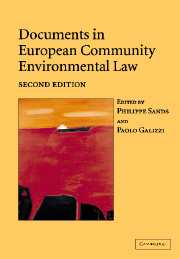Book contents
- Frontmatter
- Contents
- Preface
- PART I General principles of EC environmental law
- PART II European Community institutions and legislation
- PART III The relationship between environmental protection, financial assistance and free trade
- PART IV Procedural techniques of environmental protection
- PART V Protection of air quality
- PART VI Biodiversity and nature conservation
- PART VII Waste
- 33 Council Directive 75/442/EEC of 15 July 1975 on waste (OJ L 194 25.07.1975 p. 39)
- 34 Council Directive 91/689/EEC of 12 December 1991 on hazardous waste (OJ L 377 31.12.1991 p. 20)
- 35 Council Regulation (EEC) No 259/93 of 1 February 1993 on the supervision and control of shipments of waste within, into and out of the European Community (OJ L 030 06.02.1993 p. 1)
- 36 Council Directive 1999/31/EC of 26 April 1999 on the landfill of waste (OJ L 182 16.07.1999 p. 1)
- 37 Directive 2000/53/EC of the European Parliament and of the Council of 18 September 2000 on end-of-life vehicles (OJ L 269 21.10.2000 p. 34)
- 38 Directive 2000/76/EC of the European Parliament and of the Council of 4 December 2000 on the incineration of waste (OJ L 332 28.12.2000 p. 91)
- PART VIII Dangerous substances
- PART IX Water quality
34 - Council Directive 91/689/EEC of 12 December 1991 on hazardous waste (OJ L 377 31.12.1991 p. 20)
from PART VII - Waste
Published online by Cambridge University Press: 06 January 2010
- Frontmatter
- Contents
- Preface
- PART I General principles of EC environmental law
- PART II European Community institutions and legislation
- PART III The relationship between environmental protection, financial assistance and free trade
- PART IV Procedural techniques of environmental protection
- PART V Protection of air quality
- PART VI Biodiversity and nature conservation
- PART VII Waste
- 33 Council Directive 75/442/EEC of 15 July 1975 on waste (OJ L 194 25.07.1975 p. 39)
- 34 Council Directive 91/689/EEC of 12 December 1991 on hazardous waste (OJ L 377 31.12.1991 p. 20)
- 35 Council Regulation (EEC) No 259/93 of 1 February 1993 on the supervision and control of shipments of waste within, into and out of the European Community (OJ L 030 06.02.1993 p. 1)
- 36 Council Directive 1999/31/EC of 26 April 1999 on the landfill of waste (OJ L 182 16.07.1999 p. 1)
- 37 Directive 2000/53/EC of the European Parliament and of the Council of 18 September 2000 on end-of-life vehicles (OJ L 269 21.10.2000 p. 34)
- 38 Directive 2000/76/EC of the European Parliament and of the Council of 4 December 2000 on the incineration of waste (OJ L 332 28.12.2000 p. 91)
- PART VIII Dangerous substances
- PART IX Water quality
Summary
Editorial note
Council Directive 91/689 brings the laws of the Member States on the controlled management of hazardous waste closer to each other by applying most of the provisions of Directive 75/442 to hazardous waste and setting out additional obligations for hazardous waste (Article 1(1)–(2)). It establishes a new definition of hazardous waste by reference to three annexes, but does not apply to domestic waste (Article 1(4)–(5)).
Under the Directive all tipping (discharges) on every site must be recorded and the waste identified; there must be no mixing of different categories of hazardous waste or mixing of hazardous and non-hazardous waste, except in prescribed circumstances (Article 2). Hazardous waste must be properly packaged and labelled in accordance with international and EC standards (Article 5(1)). National authorities must draw up public plans for the management of hazardous waste (Article 6(1)). In an emergency of grave danger hazardous waste must be dealt with so as not to constitute a threat to the population or the environment (Article 7). Member States are to provide the Commission with detailed information on, inter alia, the establishments and undertakings carrying out disposal and/or recovery of hazardous waste, and the method used to treat waste, and the types and quantities of waste which can be treated (Article 8). Certain derogations allowed by Directive 75/442 cannot be applied to hazardous waste, and certain provisions of Directive 75/442 apply expressly to hazardous waste (Articles 3, 4, 6, 8).
Source: OJ L 377 31.12.1991 p. 20.
- Type
- Chapter
- Information
- Documents in European Community Environmental Law , pp. 627 - 637Publisher: Cambridge University PressPrint publication year: 2006
- 7
- Cited by



